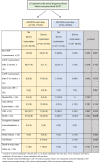Comparison of the Outcome of Patients Protected by the Wearable Cardioverter Defibrillator (WCD) for <90 Wear Days versus ≥90 Wear Days
- PMID: 33144474
- PMCID: PMC7811610
- DOI: 10.21873/invivo.12205
Comparison of the Outcome of Patients Protected by the Wearable Cardioverter Defibrillator (WCD) for <90 Wear Days versus ≥90 Wear Days
Abstract
Background/aim: The wearable cardioverter/defibrillator (WCD) is recommended to prevent sudden cardiac death (SCD). Guidelines suggest a 90 days' period, but prolongation of WCD wear time until increasing the ejection fraction (≥35%) might be suggested.
Patients and methods: A cohort of 153 patients with prescribed WCD were divided into two groups: A <90 wear days' group (n=112) vs. ≥90 wear days' group (n=41) and followed.
Results: In the first group, WCD shock occurred in 3.6% of patients, 47.3% improved in left ventricular ejection fraction (LVEF) after 3 months, and 37.5% had a cardiac implantable electronic device (CIED) implantation with appropriate implantable cardioverter defibrillator (ICD) shock events occurring in 6 patients. Two of these patients already received WCD shock therapy due to ventricular fibrillation. A 20.5% improved in LVEF after 6-12 months, but 73% were already implanted with ICD. In the second group, 4.9% received WCD shock, 34.1% improved in LVEF after 3 months, 48.8% were implanted with ICD, and 2 had ICD shocks during follow up time. LVEF improvement after 6-12 months occurred in 26.8%. ICD implantation was prevented in 7.3% of patients due to LVEF recovery.
Conclusion: Prolonging wearing days of WCD may reduce the number of inappropriate ICD implantation.
Keywords: Wearable cardioverter defibrillator (WCD); heart insufficiency; sudden cardiac death.
Copyright© 2020, International Institute of Anticancer Research (Dr. George J. Delinasios), All rights reserved.
Conflict of interest statement
All Authors declare that there are no conflicts of interest regarding this study.
Figures
Similar articles
-
Therapy optimization in patients with heart failure: the role of the wearable cardioverter-defibrillator in a real-world setting.BMC Cardiovasc Disord. 2018 Mar 15;18(1):52. doi: 10.1186/s12872-018-0790-8. BMC Cardiovasc Disord. 2018. PMID: 29544442 Free PMC article.
-
The impact of wearable cardioverter-defibrillator use on long-term decision for implantation of a cardioverter-defibrillator in a semirural acute care hospital.J Interv Card Electrophysiol. 2021 Nov;62(2):401-407. doi: 10.1007/s10840-020-00898-5. Epub 2020 Nov 17. J Interv Card Electrophysiol. 2021. PMID: 33200285 Free PMC article.
-
Avoiding Untimely Implantable Cardioverter/Defibrillator Implantation by Intensified Heart Failure Therapy Optimization Supported by the Wearable Cardioverter/Defibrillator-The PROLONG Study.J Am Heart Assoc. 2017 Jan 17;6(1):e004512. doi: 10.1161/JAHA.116.004512. J Am Heart Assoc. 2017. PMID: 28096098 Free PMC article.
-
[Patients with a wearable cardioverter-defibrillator (WCD) : Prescription, function and rehabilitation support].Herz. 2019 Aug;44(5):379-389. doi: 10.1007/s00059-017-4650-6. Epub 2017 Dec 12. Herz. 2019. PMID: 29234842 Review. German.
-
Bridging a temporary high risk of sudden arrhythmic death. Experience with the wearable cardioverter defibrillator (WCD).Pacing Clin Electrophysiol. 2010 Mar;33(3):353-67. doi: 10.1111/j.1540-8159.2009.02590.x. Epub 2009 Nov 2. Pacing Clin Electrophysiol. 2010. PMID: 19889186 Review.
Cited by
-
Wearable cardioverter defibrillator after ICD-system explantation: data from a multicenter registry.Sci Rep. 2025 Mar 1;15(1):7270. doi: 10.1038/s41598-025-91046-4. Sci Rep. 2025. PMID: 40025101 Free PMC article.
-
Cost-Utility Analysis of LifeVest® in Post-Myocardial Infarction Patients at Risk of Sudden Cardiac Death in England.Pharmacoecon Open. 2025 Mar;9(2):301-312. doi: 10.1007/s41669-024-00553-z. Epub 2025 Jan 24. Pharmacoecon Open. 2025. PMID: 39849296 Free PMC article.
-
Assessing physical activity with the wearable cardioverter defibrillator in patients with newly diagnosed heart failure.Front Cardiovasc Med. 2023 May 12;10:1176710. doi: 10.3389/fcvm.2023.1176710. eCollection 2023. Front Cardiovasc Med. 2023. PMID: 37252123 Free PMC article.
References
-
- Priori SG, Blomstrom-Lundqvist C, Mazzanti A, Blom N, Borggrefe M, Camm J, Elliott PM, Fitzsimons D, Hatala R, Hindricks G, Kirchhof P, Kjeldsen K, Kuck KH, Hernandez-Madrid A, Nikolaou N, Norekval TM, Spaulding C, Van Veldhuisen DJ, Group ESCSD. 2015 esc guidelines for the management of patients with ventricular arrhythmias and the prevention of sudden cardiac death: The task force for the management of patients with ventricular arrhythmias and the prevention of sudden cardiac death of the european society of cardiology (esc). Endorsed by: Association for european paediatric and congenital cardiology (aepc) Eur Heart J. 2015;36(41):2793–2867. doi: 10.1093/eurheartj/ehv316. - DOI - PubMed
-
- Piccini JP Sr., Allen LA, Kudenchuk PJ, Page RL, Patel MR, Turakhia MP, American Heart Association Electrocardiography and Arrhythmias Committee of the Council on Clinical Cardiology and Council on Cardiovascular and Stroke Nursing Wearable cardioverter-defibrillator therapy for the prevention of sudden cardiac death: A science advisory from the american heart association. Circulation. 2016;133(17):1715–1727. doi: 10.1161/CIR.0000000000000394. - DOI - PubMed
-
- Brooks GC, Lee BK, Rao R, Lin F, Morin DP, Zweibel SL, Buxton AE, Pletcher MJ, Vittinghoff E, Olgin JE, PREDICTS Investigators Predicting persistent left ventricular dysfunction following myocardial infarction: The predicts study. J Am Coll Cardiol. 2016;67(10):1186–1196. doi: 10.1016/j.jacc.2015.12.042. - DOI - PMC - PubMed
-
- Duncker D, Konig T, Hohmann S, Bauersachs J, Veltmann C. Avoiding untimely implantable cardioverter/defibrillator implantation by intensified heart failure therapy optimization supported by the wearable cardioverter/defibrillator-the prolong study. J Am Heart Assoc. 2017;6(1) doi: 10.1161/JAHA.116.004512. - DOI - PMC - PubMed
-
- Kutyifa V, Moss AJ, Klein H, Biton Y, McNitt S, MacKecknie B, Zareba W, Goldenberg I. Use of the wearable cardioverter defibrillator in high-risk cardiac patients: Data from the prospective registry of patients using the wearable cardioverter defibrillator (wearit-ii registry) Circulation. 2015;132(17):1613–1619. doi: 10.1161/CIRCULATIONAHA.115.015677. - DOI - PubMed
MeSH terms
LinkOut - more resources
Full Text Sources



